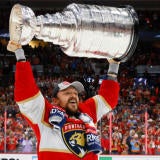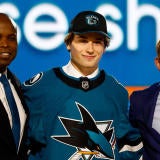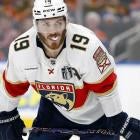 |
| Marian Gaborik has some flaws defensively, but his offensive game makes up for it. (U.S. Presswire) |
Since the NHL is still shut down for at least another month due to the ongoing lockout, we're going to occupy some of your time by counting down the Top 50 players in the NHL as decided by ... well ... me.
A number of factors went into the list including overall production, advanced metrics (via BehindtheNet.ca), personal observation, all-around play and what kind of role are they asked to play by their coaches. For example: If two players are similar in their production and are comparable in their style of play, the guy who is asked to face tougher competition or tougher assignments, among other factors, is probably going to get the edge.
To make it even easier: I basically started with the question of "If I'm building a team to win the Stanley Cup this season, who would I want on my team?"
There will be disagreements, I'm sure. And as is always the case, if a player you like is too low, or excluded, that obviously means I hate him and your team.
Previously at Eye On Hockey: Players 50-46 | Players 45-41
 40) Joe Pavelski, San Jose Sharks
40) Joe Pavelski, San Jose Sharks
2011-12 box score stats: 82 games, 31 goals, 30 assists, 61 points
2011-12 advanced stats 1.633 Corsi Quality Competition, plus-11.1 Corsi Relative, 1010 PDO
Perhaps a surprising name on the list, but Joe Pavelski has turned into one of the more complete centers in the NHL, not only producing at a consistent 25-goal, 60-point pace over the past four years, but also by helping to keep play moving up the ice against extremely tough competition.
He's also one of the best centers in the league in the faceoff circle, winning 58.7 percent of his draws in 2011-12. Perhaps even more impressive than just the overall faceoff numbers is the fact that he also dominated his faceoffs on the road, which is (in my opinion) an often-overlooked stat when looking at centers. Keep in mind, when players are at home and matched up for faceoffs they're often getting the favorable draw because the home team gets the last change. On the road, you do not get that luxury, and in 2011-12 Pavelski was fifth in the league at 56.6 percent on the road.
Playing on a team with guys like Joe Thornton and Patrick Marleau it's easy for Pavelski to get overlooked, but he's quietly become one of the most productive (and valuable) centers in the league.

39) Phil Kessel, Toronto Maple Leafs
2011-12 box score stats: 82 games, 37 goals, 45 assists, 82 points
2011-12 advanced stats .337 Corsi Quality Competition, plus-3.2, 992 PDO
The Toronto Maple Leafs paid a huge price to get Phil Kessel from the Boston Bruins a couple of years ago, giving up what turned out to be two top-10 draft picks, including a No. 2 overall selection that was used on Tyler Seguin.
General manager Brian Burke has faced a ton of criticism for it. In terms of absolute value the Leafs did give up a ton and probably would have been better off in the long term had they just kept the picks (especially in a salary cap league where the young players would have been cheaper than Kessel's contract), but they got one of the league's top goal-scoring wingers. And that's a fact that seems to get ignored when talking about what the Leafs gave up. Especially given the amount of criticism Kessel seems to face in Toronto because -- well, I'm still not entirely sure why.
The problem with the Leafs (and there are many of them) isn't Kessel, it's that they don't have more players like him.
He's one of just seven players in the NHL to score 30 goals or more in each of the past four seasons, a list that includes Jarome Iginla, Ilya Kovalchuk, Patrick Marleau, Rick Nash, Alex Ovechkin and Bobby Ryan.
In terms of total goals he's eighth over that stretch.
 38) Kris Letang, Pittsburgh Penguins
38) Kris Letang, Pittsburgh Penguins
2011-12 box score stats: 51 games, 10 goals, 32 assists, 42 points
2011-12 advanced stats: .583 Corsi Quality Competition, plus-6.4 Corsi Relative, 1031 PDO
When the Pittsburgh Penguins were waiting for Sidney Crosby to make his return to the lineup last season I argued the player they needed back the most if they had any intention of winning the Stanley Cup (reminder: they didn't make it out of the first round) wasn't their captain and best player, but actually defenseman Kris Letang.
It was a bold argument, but I still believe the Penguins missed Letang during his absence more than Crosby. Why? Even without Crosby the Penguins were still a force offensively and were never going to have a problem scoring goals. What they lacked was a clear No. 1 defenseman, which is exactly what they have with Letang.
When he's at his best Letang is a workhorse on the blue line who logs nearly 25 minutes of ice-time per game (and nearly a minute per shift) in every situation. He's usually the best skater on the ice every time he steps onto a rink, and along with his puck-moving, offensive ability he also has a bit of a mean streak to his game and isn't afraid to play physical or drop the gloves if he needs to.
His impact for the Penguins shows up in their record as well their goals-for and goals-against numbers, when he's in the lineup vs. when he's out of it. They were pretty much a .500 team without him in the lineup last season and gave up over half a goal more per game without him.
General manager Ray Shero was smart to lock him up to his current contract when he did as he still has two more seasons remaining on a deal that pays him $3.5 million per season. That's an absolute steal for a top-pairing, No. 1 defenseman.
 37) Marian Gaborik, Rangers" data-canon="New York Islanders" data-type="SPORTS_OBJECT_TEAM" id="shortcode0">
37) Marian Gaborik, Rangers" data-canon="New York Islanders" data-type="SPORTS_OBJECT_TEAM" id="shortcode0">
2011-12 box score stats: 82 games, 41 games, 35 goals, 76 points
2011-12 advanced stats: .495 Corsi Quality Competition, plus-1.3 Corsi Relative, 1019 PDO
For most of his career Marian Gaborik has always been that guy who you kept asking, "What could he produce if he ever stayed healthy?"
During his eight years with the Minnesota Wild he was always an incredibly productive player who always had the same collection of words following that up -- when he is on the ice. His production made even more impressive by the fact that he was playing in Jacques Lemaire's tight-checking, defense first system. During the 2007-08 season for example Gaborik did something that only one other player has accomplished on a Lemaire-coached team: He scored 40 goals in a single season (Mats Naslund in 1984-85 was the other). That's no small accomplishment.
When he hit the free-agent market prior to the 2009-10 season the New York Rangers were waiting to do what they do in the summer and hand over a huge contract to one of the top free agents available on the market.
After three years they've been rewarded with one of the best goal-scorers in the NHL over that stretch, as Gaborik has already topped the 40-goal mark in two of the three years, and is fifth in the NHL in terms of goals-per-game over the past three years. He still has his shortcomings as a player defensively (though, I think sometimes it's a bit overstated), but he's a threat to score every time he steps on the ice and is one of the best offensive players in the league.
 36) Jordan Staal, Carolina Hurricanes
36) Jordan Staal, Carolina Hurricanes
2011-12 box score stats: 62 games, 25 goals, 25 assists, 50 points
2011-12 advanced stats: 1.461 Corsi Quality Competition, plus-4.8 Corsi Relative, 984 PDO
Carolina Hurricanes general manager Jim Rutherford wanted to make a big splash this summer, and he ended up making two. One was the addition of sniper Alex Semin in free agency. The bigger one was swinging a draft-day trade to land center Jordan Staal from the Pittsburgh Penguins in exchange for Brandon Sutter, Brian Dumolin, and the No. 8 overall pick in the draft (which Pittsburgh used on Portland Winterhawks defenseman Derrick Pouliot).
It's a great trade for all parties involved. The Hurricanes landed a top player, the Penguins received a strong replacement to handle their third-line duties behind Crosby and Evgeni Malkin -- and a couple of more defensemen to add to their stable of prospects on the blue line. Plus, Staal gets an opportunity to flourish as a go-to player offensively. And I think he will. Actually, by the end of the season we might be looking at Staal as one of the top 20 or 15 players in the league.
In Pittsburgh, Staal was constantly matched up against other teams' top players, and despite playing some of the toughest minutes in the NHL, he was still a force when it came to driving play up the ice and controlling the puck -- and was on a pace to set career high in scoring had he not missed 20 games due a leg injury. A lot of his increase in goal-scoring last year could be attributed to a spike in his shooting percentage, which ended up being 16.8, a number he probably won't sustain. But his offensive game has clearly taken big steps forward in recent years. At 6-feet-4, 220 pounds, he can be a force physically with the puck. When he uses his size he is nearly unstoppable when it comes to controlling the puck and working it along the boards. And then there's his defensive game, which will probably one day earn him a Selke Trophy as the league's best defensive forward.
The Hurricanes should be considered a real threat to win the Southeast Division this season (whenever it starts) and the addition of Staal is a big reason why.
For more hockey news, rumors and analysis, follow @EyeOnHockey and @agretz on Twitter and like us onFacebook

















